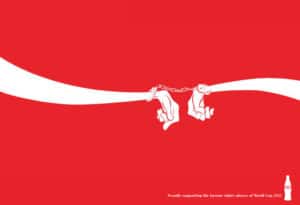In a previous post, I outlined the importance of brand authenticity and how public relations can help tell an authentic story. But what happens when brands lack authenticity? They’re in danger of being attacked by disparaging images and stories, known as doppelgänger brand images (DBIs).
Just what are DBIs and where are they found? These negative images and stories are found across the Internet—social media, blogs, Reddit, news outlets and websites of anti-brand activists. One example of a DBI emerged as result of the controversy surrounding the 2022 FIFA World Cup in Qatar. An artist altered Coca-Cola’s logo, depicting it as hands bound by handcuffs as a criticism for supporting the tournament.

Coca-Cola criticized with caption reading: ‘Proudly supporting the human rights abuses of World Cup 2022’
Most DBIs target well-known brands like Pepsi and Kmart. But as Voxus represents tech companies, it’s worth noting that they also target technological innovations. This is because new technologies are often disruptive, which can be perceived as threatening and/or be met with skepticism.
What should a brand do to stop doppelgängers? That’s where PR comes in.
Monitor for brand doppelgängers
PR isn’t just pitching stories to the media. Another component is listening for all manner of mentions and analyzing sentiment. Brands should use tools like Google Alerts to be notified of mentions. In monitoring, you’ll pick up on clues about negative impressions about a brand, product or service.
Continue monitoring negative mentions
When you come across negative mentions, keep an eye on them. You’ll also want to see how someone’s DBI is resonating with his or her audience. This can serve as a diagnostic tool, revealing weaknesses in a brand’s story or activities.
Clean up the brand image in four steps
PR can help rid disparaging images and stories, following this process:
- Craft a story that addresses or bypasses a DBI
- Seek validation of a new image from authorities like industry analysts
- Consistently communicate the story across an organization and to brand ambassadors
- Ensure speedy adoption of the image.
Tell your story
Communicate about a brand in an authentic manner to press, thought leaders, ambassadors and other stakeholders.
PR can help organizations combat troublesome brand doppelgängers. Through effective monitoring, communication and testing, brands can uncover how they’re perceived and adjust to find their authentic story.

